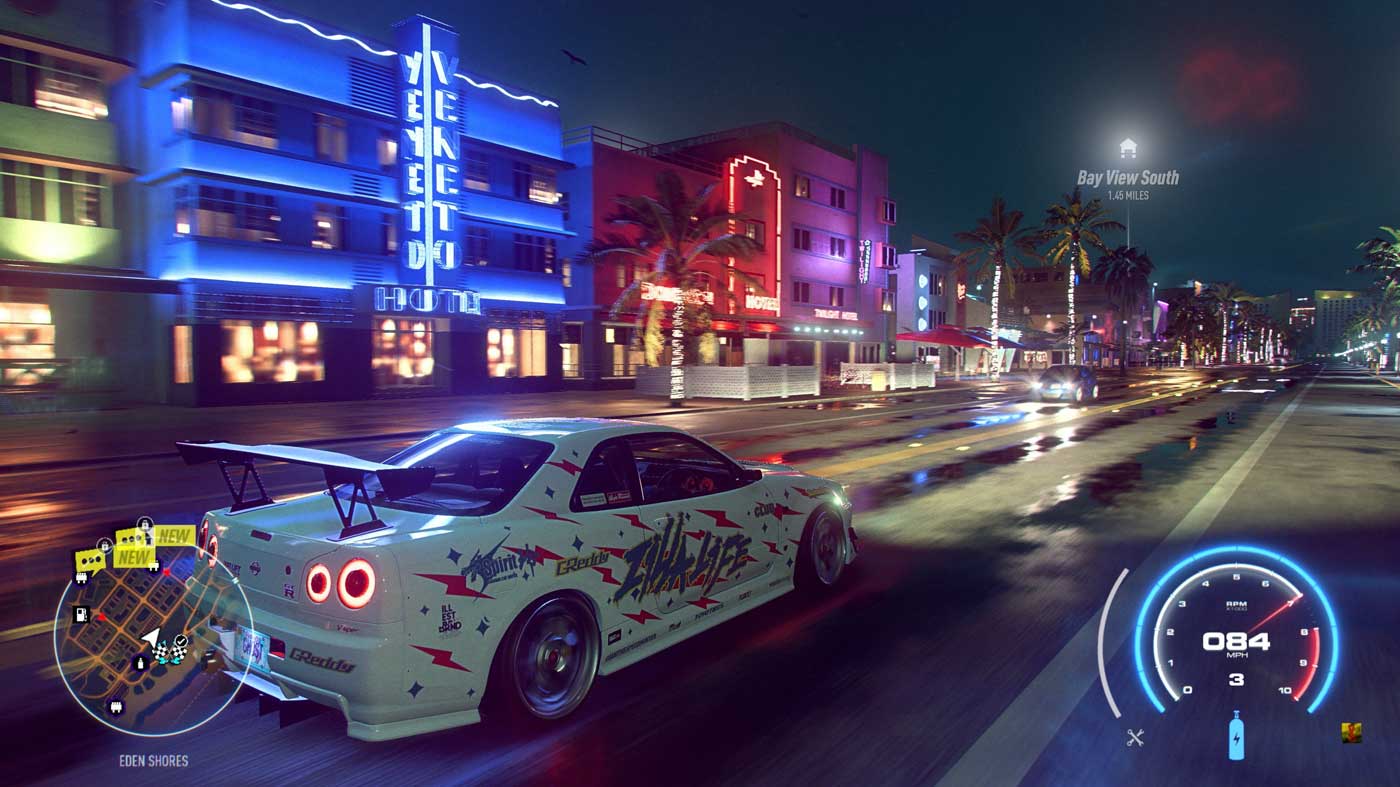After the lacklustre Payback, it seemed that people didn’t feel that same need for speed as they once did. Its failure probably can’t be tied to a single misfire from developer Ghost Games, though it became clear when the trailer for Need for Speed: Heat landed that there was one sought-after ingredient and that was the boys in blue. Heat’s rogue police force hits like a truck and creates a tense, white knuckle stranglehold on the streets of Palm City as their grip so often tightens to the point that escape is an impossible feat, but a satisfying one should you shake their grasp.
These high-octane chases have always been the bread and butter of Need for Speed and, though it might appear to be low-hanging fruit to most, it was the right one to pick from the tree for Ghost Games to give their series back its mojo.

Heat’s open-world of Palm City is largely inspired by real-world Miami, Florida and other areas expected to be frequented by elderly vacationers. It is apparent from the get-go that Ghost Games took a look at other open-world racers that have impacted the scene over the last generation and placed their strengths at the top of their own drawing board. The evergreen Burnout Paradise looks to be a deep well they’ve gone back to in crafting their own world which is, in many ways, even better than Criterion’s own. Though it rains sideways ever other minute and doesn’t call to mind paradise, every small thing to do is straight from that Burnout playbook. Intersections overrun with speed traps, tangled roads are a playground for drift trials and there are even ever-familiar billboards to plough through, plastered with Lt. Frank Mercer’s watchful gaze.
Palm City’s map is tight, rather compact interconnected network of roads that serve the game’s many side activities. There are no dead ends and no redundancy in their design which makes getting around a blast, knowing that no matter what your aim is, Palm City is going to be able to cater. It’s when Heat’s story plays out that things grind to a frustrating halt.

Heat’s story isn’t bad, quite the contrary, it’s a standard blockbuster premise that’d be right at home between the opening and closing credits of the next Fast and Furious sequel. Though the turns are predictable and played out, the rogue task force’s extreme conduct casts them as contemptible villains who you can’t help but hate. It’s a shame it plays out in such a frustrating way, with level-gating killing the flow, pacing and any urgency the story hoped to drum up. Thanks to the interchangeable day-night cycle, the game’s economy is two-fold. Sanctioned day racing nets you folding money to purchase cars, upgrades and even garb for yourself, whereas races under the blanket of the night help your rep along and it is this rank that is tied intrinsically to story progression.
So often you’ll finish a story mission that sermonises the urgency of the situation only to lock you out of the subsequent resolve until you climb three more ranks. It makes other races essential busywork rather than enjoyable side content for when you’re through with Heat’s story.

Even more bewildering is that Heat chooses not to exposit within its carefully crafted cutscenes, instead opting to lump players with the driving equivalent of the ‘walk and talk’. Instead of speeding through hairpins, we’re forced to tail a non-playable friendly to the race meet like a Sunday driver so that they can wax lyrical about the situation at hand. It feels at odds with the game’s core ethos, but even this isn’t as bad as the ‘Follow the Law’ quest which is a tailing mission in a racing game.
When you do get to test the rubber on the blacktop Heat is a terrific racing game and it handles like a treat. The controls feel automatic and inborn, like an instinct passed down from a higher power and this is how a racing game should feel. Long before familiarity with the game’s dense city set in, there was a satisfaction that came from careening through Palm City on gut alone. Ghost Games have really captured the essence of Need for Speed within the game’s mechanics, its city and the controls, it’s like slipping into an old pair of slippers. It’s comfortable.

Though smooth, Need for Speed isn’t without its faults. When the game shits itself, it tends to have to throw away its pants because it does a damn good job of it. There aren’t persistent glitches, but when they hit it’s in numbers from smaller things like starting line models clipping over the top of a car to being started in a race facing the completely wrong direction. There’s also a bizarre A.I. breakpoint that’s hard to miss when racing where fellow racers hold with you with aggressive enthusiasm until a certain gap is placed between you both and then it’s almost like they despawn. A lead of 300ft jumps to a mile in no time as if the second-place car has come to a dead stop.
Being able to dive customisation in Heat is one in the handful of real pleasures the game offers. There are unfortunate limitations in place that hamstring our ability to recreate ourselves in the player-character’s appearance, though it can’t be said that our dress code is limited with a decent range of what I can only assume as a man nearing the hill’s crest, and soon to be over it, are trending outfits. When the night-life lets up and you’re afforded a chance to breathe, popping the bonnet and tinkering offers some of the more relaxing moments in Heat. You can’t go to the same lengths in fine-tuning as other racers but that’s hardly a disappointment because too much time spent on the tools would certainly rob Need for Speed of its nucleus which is spinning four wheels on the open road.
Need for Speed: Heat is a pulsating racing experience let down by a number of other factors that wouldn’t often be at home in a game like this. Frustrating level-gating and pacing force Heat to play out with a sense that speed isn’t needed in any way, shape or form. It’s only when you’re free from the systems that drive the game’s commendable story forward that Need for Speed feels like itself again.






